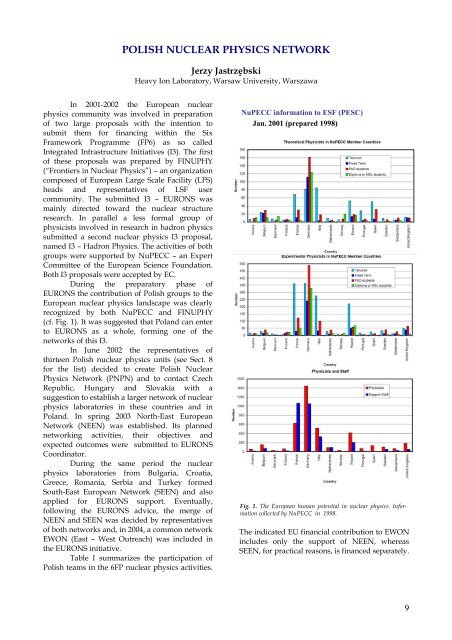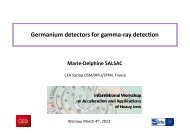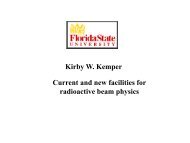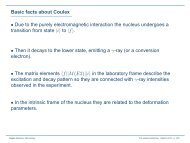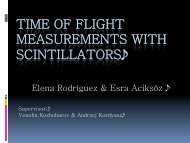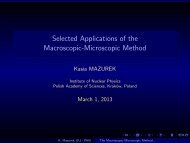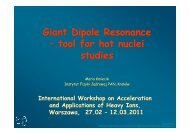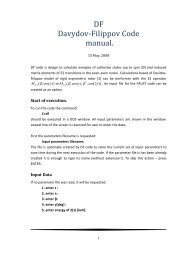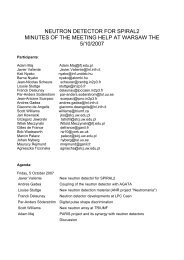nuclear physics in poland 1996 â 2006
nuclear physics in poland 1996 â 2006
nuclear physics in poland 1996 â 2006
- No tags were found...
Create successful ePaper yourself
Turn your PDF publications into a flip-book with our unique Google optimized e-Paper software.
POLISH NUCLEAR PHYSICS NETWORKJerzy JastrzębskiHeavy Ion Laboratory, Warsaw University, WarszawaIn 2001-2002 the European <strong>nuclear</strong><strong>physics</strong> community was <strong>in</strong>volved <strong>in</strong> preparationof two large proposals with the <strong>in</strong>tention tosubmit them for f<strong>in</strong>anc<strong>in</strong>g with<strong>in</strong> the SixFramework Programme (FP6) as so calledIntegrated Infrastructure Initiatives (I3). The firstof these proposals was prepared by FINUPHY(“Frontiers <strong>in</strong> Nuclear Physics”) – an organizationcomposed of European Large Scale Facility (LFS)heads and representatives of LSF usercommunity. The submitted I3 – EURONS wasma<strong>in</strong>ly directed toward the <strong>nuclear</strong> structureresearch. In parallel a less formal group ofphysicists <strong>in</strong>volved <strong>in</strong> research <strong>in</strong> hadron <strong>physics</strong>submitted a second <strong>nuclear</strong> <strong>physics</strong> I3 proposal,named I3 – Hadron Physics. The activities of bothgroups were supported by NuPECC – an ExpertCommittee of the European Science Foundation.Both I3 proposals were accepted by EC.Dur<strong>in</strong>g the preparatory phase ofEURONS the contribution of Polish groups to theEuropean <strong>nuclear</strong> <strong>physics</strong> landscape was clearlyrecognized by both NuPECC and FINUPHY(cf. Fig. 1). It was suggested that Poland can enterto EURONS as a whole, form<strong>in</strong>g one of thenetworks of this I3.In June 2002 the representatives ofthirteen Polish <strong>nuclear</strong> <strong>physics</strong> units (see Sect. 8for the list) decided to create Polish NuclearPhysics Network (PNPN) and to contact CzechRepublic, Hungary and Slovakia with asuggestion to establish a larger network of <strong>nuclear</strong><strong>physics</strong> laboratories <strong>in</strong> these countries and <strong>in</strong>Poland. In spr<strong>in</strong>g 2003 North-East EuropeanNetwork (NEEN) was established. Its plannednetwork<strong>in</strong>g activities, their objectives andexpected outcomes were submitted to EURONSCoord<strong>in</strong>ator.Dur<strong>in</strong>g the same period the <strong>nuclear</strong><strong>physics</strong> laboratories from Bulgaria, Croatia,Greece, Romania, Serbia and Turkey formedSouth-East European Network (SEEN) and alsoapplied for EURONS support. Eventually,follow<strong>in</strong>g the EURONS advice, the merge ofNEEN and SEEN was decided by representativesof both networks and, <strong>in</strong> 2004, a common networkEWON (East – West Outreach) was <strong>in</strong>cluded <strong>in</strong>the EURONS <strong>in</strong>itiative.Table I summarizes the participation ofPolish teams <strong>in</strong> the 6FP <strong>nuclear</strong> <strong>physics</strong> activities.NuPECC <strong>in</strong>formation to ESF (PESC)Jan. 2001 (prepared 1998)Fig. 1. The European human potential <strong>in</strong> <strong>nuclear</strong> <strong>physics</strong>. Informationcollected by NuPECC <strong>in</strong> 1998.The <strong>in</strong>dicated EU f<strong>in</strong>ancial contribution to EWON<strong>in</strong>cludes only the support of NEEN, whereasSEEN, for practical reasons, is f<strong>in</strong>anced separately.9


